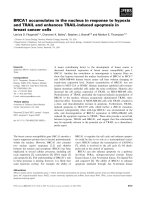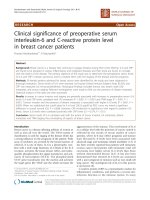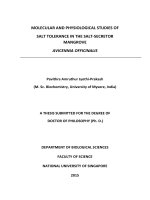FUNCTION AND MECHANISM STUDIES OF TRPV4 IN BREAST CANCER METASTASIS
Bạn đang xem bản rút gọn của tài liệu. Xem và tải ngay bản đầy đủ của tài liệu tại đây (4.32 MB, 202 trang )
FUNCTION AND MECHANISM OF TRPV4 IN BREAST
CANCER METASTASIS
CHOONG LEE YEE
B.SC (HONS)
UNIVERSITI TEKNOLOGI MALAYSIA
A THESIS SUBMITTED FOR THE DEGREE OF
MASTERS OF SCIENCES
DEPARTMENT OF BIOCHEMISTRY
NATIONAL UNIVERSITY OF SINGAPORE
2013
DECLARATION
I hereby declare that the thesis is my original work and it has
been written by me in its entirety. I have duly acknowledged all
the sources of information which have been used in the thesis.
This thesis has also not been submitted for any degree in any
university previously.
_________________
CHOONG LEE YEE
20 March 2013
II
ACKNOWLEDGEMENTS
First and foremost I offer my sincerest gratitude to my supervisor, Assistant
Professor Dr. Lim Yoon Pin, Department of Biochemistry NUS for his endless
encouragement, support, guidance and helps. I would like to thank National
University of Singapore for allowing me to pursue this degree with their generous
research scholarship.
In my daily life I have been blessed with a friendly and cheerful group of
fellow colleagues. It would have been a lonely laboratory without them. My heartfelt
thanks to the past and present colleagues especially Dr. Sheryl Tan, Mdm. Pan
Mengfei, Dr. Lim Shen Kiat, Dr. Law Kai Pong, Dr. Shirly Chong, Mdm. Qianfeng
and Mr. Victor Tan for always willing to provide assistance. My deepest gratitude to
my dearest friends, Ms. Yuki Yip and Mr. Edmus Oh for their valuable motivation
and encouragement. Thanks for being such wonderful friends and I will always
treasure our friendships.
I would like to express my deepest appreciation to my family, especially my
parents, brother and sisters for their love and blessing. Finally, I would like to thank
my dearest husband Kian Chuan and my lovely daughter Avelyn who were always
there cheering me up and stood by me through the good times and bad. I would like to
apologize to many individuals whose valuable contributions to this project were
unable to be cited due to space restrictions.
Choong Lee Yee
20 March 2013
III
ROLES AND CONTRIBUTIONS OF COLLABORATORS
Prof. Dr. Christian Harteneck
-----------
from Universitat Tǘbingen,
Germany
Provides TRPV4 antibodies and
plasmids, RES019-29 TRPV4 blocker
and TRPV4-T Rex HEK293 cells,
intellectual contributions
Dr. Lim Chwee Teck and Dr.
---------Vedula Sri Ram Krishna from
Nanobiomechanics Lab,
National University of Singapore
Micropipette aspiration
Dr. Low Boon Chuan, Dr.Kenny ---------Lim Gim Keat and Archna Ravi
RCE mechanobiology lab,
National University of Singapore
GTPase assays
Dr. Marie Chiew-Shia Loh
previously from Cancer Science
Institute of Singapore, National
University of Singapore
----------
Statistical analyses
Dr. Thomas Putti from National
University of Hospital, National
----------
Provides clinical samples and
clinicohistopathological data
Dr. Wong Chow Yin from
Singapore General Hospital,
Singapore
----------
Provides clinical samples and
clinicohistopathological data
Dr. Brendan Pang and Dr.
Benedict Yan from National
----------
Histological analyses
University of Singapore
University of Hospital, National
University of Singapore
IV
TABLE OF CONTENTS
DECLARATION
II
ACKNOWLEDGEMENTS
III
ROLES AND CONTRIBUTIONS OF COLLABORATORS
IV
TABLE OF CONTENTS
V
SUMMARY
IX
LIST OF FIGURES
XIII
LIST OF TABLES
XIV
LIST OF SUPPLEMENTARY TABLES
XV
LIST OF ABBREVIATIONS
XVI
Chapter 1 Introduction
1
1.1
Importance of Ca2+ homeostasis and signaling
2
Ca2+ deregulations and cancers
2
1.1.1
1.2
Tumor metastasis
Ca2+ and metastatic behaviors
1.2.1
3
6
1.3
Ca2+ channels and TRP channels
8
1.4
TRPV4
11
1.4.1
Structure of TRPV4
12
1.4.2
Activation and regulation of TRPV4
14
1.4.3
TRPV4 associated proteins
15
V
1.5
1.6
When calcium transport and signaling go wrong
16
1.5.1
17
TRPV4 in human diseases
Research objectives
20
Chapter 2 Materials and Methods
21
2.1
2.2
2.3
2.4
2.5
2.6
2.7
2.8
2.9
2.10
2.11
2.12
2.13
2.14
2.15
2.16
2.17
2.18
22
22
23
24
25
25
26
27
28
28
29
30
30
31
31
32
33
35
Chemicals and reagents
Antibodies
Cell culture and cell lysis
Transfection
Drug treatment
Immunoprecipitation
Immunoblotting
Immunohistochemistry
Immunofluorescence
Cell proliferation assay
Wound healing assay
Chemotaxis assay
Invasion assay
Transendothelial migration assay
Xenograft
Micropipette aspiration
Intracellular calcium measurement
Real-time PCR
Chapter 3 Results
36
3.1
TRPV4 is overexpressed in breast cancer cell lines and tissues
3.1.1 Phosphoproteome of the breast cancer metastasis model
3.1.2 Bioinformatics and the characterization of the differentially
expressed phosphoproteins across the BCM model
3.1.3 Upregulation of TRPV4 protein and mRNA across the BCM
model
3.1.4 Upregulation of TRPV4 in invasive human breast cancer cell
lines and tissues
37
37
42
TRPV4 is a positive regulator of breast cancer metastasis
3.2.1 Function of TRPV4 in breast cancer cell movement, invasion
and transendothelial migration
3.2.2 Silencing of TRPV4 reduce the nodules’ size and number in
the lungs of the mice
62
62
3.2
45
52
68
VI
3.3
Cellular and molecular mechanism of TRPV4 in cellular
processes associated with metastasis
3.3.1 TRPV4 maybe necessary for cancer cell plasticity that
promotes the intra-/ extravasation process
74
74
77
77
83
3.4
Mapping the pathways of TRPV4
3.4.1 Activation of TRPV4 stimulate the AKT and FAK pathways
3.4.2 Does AKT activation by TRPV4 mediated downregulation of
E-cadherin and β-catenin proteins?
3.5
Function of TRPV4 and its signaling during metastatic processes 87
are associated with its role in increasing intracellular Ca2+
concentration
3.6
Constitutively active AKT can rescue phenotype of TRPV4silenced cells
92
3.7
TWIST mediates downregulation of E-cadherin
93
Chapter 4 Discussion
4..1
4..2
4..3
Ca2+ mediates activation of AKT/ PI3K signaling pathway by
TRPV4
Potential role of transcriptional repression and proteosomal
degradation in TRPV4-mediated downregukation of E-cadherin
expression
Limitation of the approaches
97
98
100
102
Chapter 5 Future directions
103
5.1
104
5.2
5.3
5.4
5.5
Functional analysis of TRPV4 domains and its naturally
occurring mutations
TRPV4 blockers
Role of proteosomal degradation, transcription repression and
other regulators of TRPV4 signaling pathway
Role of phosphorylation of TRPV4 in metastasis
Conclusion
105
105
107
108
List of publications
109
Bibliography
110
VII
Appendix I Permission to reproduce: Figure 1.1 and 1.2
126
Appendix II Permission to reproduce: Table 1.1
131
Appendix III Permission to reproduce: Figure 1.4
135
Appendix IV Permission to reproduce: Figure 1.6
140
VIII
SUMMARY
Transient Receptor Potential Vanilloid subtype 4 (TRPV4), a non-selective
calcium-permeable cation channel was discovered by our laboratory to be a
novel breast cancer metastasis-associated protein. TRPV4 was found to be
upregulated in invasive breast cancer cell lines and tumor breast tissues. It has
been shown that 4α-PDD induced activation of TRPV4 led to a rise in
intracellular Ca2+ concentration. Our in-vitro studies indicated that silencing
of TRPV4 significantly abolished the invasiveness and the ability of murine
mammary breast cancer metastatic cells to transmigrate through endothelial
cells, but not the proliferation of the cells. Furthermore, in-vivo studies
demonstrated that knockdown of TRPV4 significantly reduced the number
and size of metastatic nodules in the lungs of SCID mice. These effects of
TRPV4 knockdown were associated with a reduction in the plasticity of the
cancer cells and diminution of intracellular Ca2+ concentration. Interestingly,
activation of TRPV4 led to Ca2+-dependent activation of AKT/ PI3K
pathways and downregulation of cell adhesion proteins such as E-cadherin
and β-catenin, which may account for the decrease in cancer cell plasticity
following TRPV4 knockdown. Our preliminary data showed that Twist might
be involved in AKT-mediated repression of E-cadherin expression. Studies
are currently under way in our laboratory to also investigate the potential role
of proteosomal degradation in TRPV4-mediated downregulation of Ecadherin and β-catenin. In conclusion, this study shows that TRPV4 plays a
novel role in cellular processes associated with metastasis and provides
insights into the mode of action of TRPV4 in metastasis.
IX
LIST OF FIGURES
1.1
Metastatic Tropism Carcinomas
4
1.2
The Invasion-Metastasis Cascade
5
1.3
Typical subunit arrangement of a skeletal muscle voltage-gated
calcium channel
8
1.4
Intracellular location and putative activation mechanisms of TRP
channels
10
1.5
Schematic overview of TRPV4’s predicted structural and functional
components.
12
1.6
Most potent TRPV4 agonists
14
3.1
Pervanadate induced tyrosine phosphorylation in Breast Cancer
Metastasis (BCM) model
38
3.2
Schematic diagram showing the workflow of iTRAQ-based
experiments to identify PV-induced tyrosine phosphorylation substrates
in Breast Cancer Metastasis (BCM) model
39
3.3
The top most canonical pathway associated with the gene list is that of
leukocyte extravasation signaling
43
3.4
Biological interaction network (BIN) of the proteins identified in PVinduced phosphotyrosine-proteome
45
3.5
Validation of known and potentially novel tyrosine-phosphorylated
protein identified in BCM cell lines.
46
3.6
The MS/MS spectra of the 3 iTRAQ peptides for TRPV4 inset shows
the intensity of the iTRAQ reporter ions derived from TRPV4 across
the cell lines in BCM model.
48
3.7A Immunoprecipitation and immunoblotting of TRPV4 in the BCM cell
lines
51
3.7B Immunofluorescence (IF) of TRPV4 in the BCM cell lines
51
3.8
52
The expression of TRPV4 in BCM model was examined using realtime PCR
X
3.9A
Immunoblotting of TRPV4 on the MCF10AT model
54
3.9B
Immunoblotting of TRPV4 on a panel of human cell lines
54
3.10
Bar chart distribution of IHC scores for TRPV4 on matched normal
(N), ductal carcinoma in situ (DCIS) and invasive ductal carcinomas
(IDC)
57
3.11
The expression patterns of TRPV4 in 85 samples matched metastatic
breast cancers and invasive ductal carcinomas (IDC) from tissue
microarray
58
3.12
Box plot distribution of IHC scores for TRPV4 on normal (N), ductal
carcinoma in situ (DCIS), invasive ductal carcinomas (IDC) and
metastatic breast cancers
58
3.13A Representative IHC images showing upregulation of TRPV4 in
matched clinical samples across the breast cancer progression.
60
3.13B Representative IHC images showing TRPV4 expression in tissue
60
microarray of breast cancer invasion versus matched metastatic breast
cancer tissues
3.13C Immunohistochemistry of TRPV4 in the absence or presence of
competing or control peptides
60
3.14
62
Kaplan-Meier analysis of disease-free survival (DFS) based on
TRPV4 protein expression level from the breast cancer patients
dataset
3.15A 4T07 cells transfected with TRPV4-specific siRNA sequences (Seq
#1 and Seq #3) or an irrelevant sequence (Luc) were analysed for
their TRPV4 expression.
64
3.15B Wound-healing assays showing that TRPV4 siRNA (200nM) inhibits
the migration of 4T07 murine mammary epithelial tumor cells.
64
3.15C The percentage of gaps was estimated for 0hr, 8hr, 16hr and 24hr; and 64
the chart was plotted.
3.16
Chemotaxis assays showing that TRPV4 siRNA (200nM) inhibits the
migration of 4T07 murine mammary epithelial tumor cells
65
3.17
Cell invasion assays showing that TRPV4 siRNA (200nM) inhibits the 65
migration of 4T07 murine mammary epithelial tumor cells
3.18
Transendothelial migration assays showing that TRPV4 siRNA
67
XI
(200nM) inhibits the transendothelial migration of 4T07 cancer cells
3.19
Proliferation assays showing that TRPV4 siRNA (200nM) has no
statistically significant effect on the 4T07 cells proliferation.
68
3.20
4T1 cells transfected with TRPV4-specific siRNA sequences (Seq #1
and Seq #3) or an irrelevant sequence (Luc) were analysed for their
TRPV4 expression
70
3.21
Histological analyses showing staining of lung tissue sections from
mice injected with 4T1 cells transfected with TRPV4-specific siRNA
sequences (Seq #1 and Seq #3) or an irrelevant sequence (Luc)
70
3.22A Number of nodules with distinct sizes present in lungs harvested from
SCID mice injected with TRPV4 knocked down and control 4T1
cells.
71
3.22B Box plots showing the distribution of nodules size and number of
nodules
71
3.23A Representative IHC images showing expression of TRPV4 in the
lungs tissue sections from the SCID mice injected with ctrl and
TRPV4-knockdown 4T1 cells
73
3.23B Box plot showing expression of TRPV4 on the lungs tissue sections
from the SCID mice injected with ctrl and TRPV4-knockdown 4T1
cells
73
3.24
The percentage of 4T07 cells that formed blebs at a pressure rate of 2
Pa/sec
76
3.25
The average of pressure when the blebs were started to be formed
76
3.26
Changes in levels of phospho-proteins and non-phospho proteins upon
4α-PDD stimulation for 15 mins and 16hrs in 4T07 cell line.
80
3.27
Changes in levels of phospho-proteins and non-phospho proteins
upon 4α-PDD stimulation for 15 mins and 16 hrs in TRPV4knockdown 4T07 cells
82
3.28
Immunoblotting of TRPV4 upon 10µM of 4α-PDD stimulation and/
or 10µM Ruthedium Red (RR) on 4T07 cells for 16hrs
83
3.29
Effects on expression levels of phosphorylated S6, phosphorylated
AKT, phosphorylated FAK, E-cadheria and β-catenin in the presence
and absence of 5µM AKT inhibitor IV
85
3.30
Lack of effects of FAK inhibitor on expression levels of E-cadherin
86
XII
and β-catenin.
3.31
Intracellular Ca2+ measurement indicates that TRPV4 siRNA decrease 88
store-operated Ca2+ influx in 4T07 cells
3.32
Effects of BAPTA-AM and EGTA Ca2+ chelators on TRPV4
signaling. 4T07 cells were stimulated with 4α-PDD for 15 mins.
90
3.33
Effects of BAPTA-AM and EGTA Ca2+ chelators on TRPV4
signaling. 4T07 cells were stimulated with 4α-PDD for 16 hrs.
91
3.34A Overexpression of constitutively active AKT construct rescue the
effect of TRPV4 silencing on the expression of phosphorylated AKT
and E-cadherin
93
3.34B Overexpression of constitutively active AKT construct rescue the
transmigration effect of TRPV4 knockdown
93
3.35A The mRNA expression of E-cadherin in 4T07 cells upon different
time-point of 4α-PDD stimulation
94
3.35B The protein expression of E-cadherin in 4T07 cells upon different
time-point of 4α-PDD stimulation
94
3.36A 4T07 cells transfected with Twist-specific siRNA sequences (Seq #1
and Seq #2) or an irrelevant sequence (Luc). The transfected lysated
were analysed for the expression of Twist and E-cadherin
96
3.36B The expression of E-cadherin in 4T07 cells silenced with Twistspecific siRNA
96
4.1
100
Schematic representation of the proposed signaling mechanism that
promotes metastasis through the activation of TRPV4 in breast cancer
XIII
LIST OF TABLES
1.1
Plasmalemmal and endolemmal Ca2+-permeable channels in
migration and metastasis
7
1.2
Naturally occurring TRPV4 mutations
19
3.1
Relative quantification of 4G10 anti-phosphotyrosine antibodiesenriched proteins in PV-stimulated of Breast Cancer Metastasis
(BCM) model
40
3.2
Summary of top three associated network functions.
42
3.3
Statistical analyses of the relationships between different factors
using experimental and clinical data from normal and tumor samples
61
3.4
Determination of the mice with distinct number of lung metastases
nodules
71
3.5
Quantification of the percentage of 4T07 cells that formed blebs and
the average of pressure at which bleb developed
74
5.1
The major phosphorylation sites of TRPV4 in response to different
stimulators
108
XIV
LIST OF SUPPLEMENTARY TABLES
Supplementary Table 1
Peptide summary
Supplementary Table 2
IPA summary
Supplementary Table 3
Cononical pathways
Supplementary Table 4
IHC scoring and clinicohistopathological data
Supplementary Table 5
Statistical analyses of IHC
Supplementary Table 6
Nodules counting and IHC
XV
LIST OF ABBREVIATIONS
°C
3'UTR
4α-PDD
aa
AKT
BAPTA
BCM
model
BSA
Ca
2+
degree Celsius
3' untranslated region
4-alpha-Phorbol 12,13-Didecanoate
amino acid
AKR mouse T-cell lymphoma-derived oncogenic product
1,2-bis(o-aminophenoxy)ethane-N,N,N',N'-tetraacetic acid
breast cancer metastasis model
bovine serum albumin
calcium
Ctrl
control
DMSO
E. coli
ECL
ECM
EDTA
EGFR
EGTA
ERK
ESI
FBS
GTP
GTPase
HA
HGF
HRP
Hrs
IF
IGF-1
IHC
IP
IP3
iTRAQ
Kd
kDa
LC-MS/MS
Luc
MAPK
MEK
MEM
Dimethyl sulfoxide
Escherichia coli
enhanced chemiluminescence
extracellular matrix
ethylene-diamine tetra-acetic acid
epidermal growth factor receptor
ethylene glycol tetraacetic acid
extracellular signal-regulated kinase
electrospray ionization
fetal bovine serum
guanosine triphosphate
guanosine triphosphatase
haemagglutinin
hepatocyte growth factor
horseradish peroxidase
hepatocyte growth factor-regulated tyrosine kinase substrate
Immunofluorescence
insulin growth factor 1
Immunohistochemistry staining
immunoprecipitation
inositol 1,3,5-trisphosphate
isotope tagging for relative and absolute quantification
knockdown
kilo Dalton
liquid chromatography-tandem mass spectrometry
Luciferase
mitogen-activated protein kinase
mitogen activated extracellular signal regulated kinase
modified eagles medium
XVI
Mets
mg
MG132
MgCl2
mL
mM
MMTS
MTS
Na3VO4
NaCL
NaF
ng
NID
N-terminal
PBS
PBST
PDGF
PDK-1
PH
PI3,5P2
PI3K
PI3P
PIP2
PIP3
PKC
PLCγ
PM
PMA
PNS
PTB
PV
PVDF
pY
PY20H
Rab11
Rab4
Rab5
Rab7
Raf
rpm
RPMI
RR
RTK
Metastasis
milligram
N-(benzyloxycarbonyl)leucinylleucinylleucinal
magnesium chloride
millilitre
millimolar
methyl methanethiosulfonate
3-(4,5-dimethylthiazol-2-yl)-5-(3-carboxymethoxyphenyl)-2-(4sulfophenyl)-2H-tetrazolium, inner salt
sodium orthovanadate
sodium chloride
sodium fluoride
nanogram
non-ionic denaturing
amino (NH2)-terminal
phosphate buffered saline
phosphate buffered saline with Tween 20
platelet-derived growth factor
phosphoinositide-dependent kinase-1
Pleckstrin homology
phosphatidylinositol-3,5-bisphosphate
phosphatidylinositol 3-kinase
phosphatidylinositol 3-phosphate
phosphatidylinositol-4,5-bisphosphate
phosphatidylinositol-3,4,5-trisphosphate
protein kinase C
phospholipase Cγ
plasma membrane
phorbol myristate acetate
post nuclear supernatant
phosphotyrosine binding
Pervanadate
polyvinylidene difluoride
phosphotyrosine
phosphotyrosine antibody conjugated to horseradish peroxidase
Ras-associated protein 11
Ras-associated protein 4
Ras-associated protein 5
Ras-associated protein 7
Rapidly growing fibrosarcoma
revolutions per minute
Roswell Park Memorial Institute
Ruthedium red
receptor tyrosine kinase
XVII
S1
S2
S3
SCX
SDS-PAGE
Ser
TEMED
TRP
TRPC
TRPM
TRPV
TRPV4
Tyr
V
WT
Y
g
l
M
[Ca2+]i
SiRNA sequence 1
SiRNA sequence 2
SiRNA sequence 3
strong cation exchange
sodium dodecyl sulphate-polyacrylamide gel electrophoresis
Serine
N,N,N',N'-tetramethyl-ethylene-diamine
Transient receptor potential
TRP canonical proteins
named after the initial member, melastatin
named after the vanilloid receptor VR1
Transient receptor potential cation channel subfamily V member 4
Tyrosine
voltage
wild type
Tyrosine
microgram
microlitre
micromolar
concentration of intracellular calcium
XVIII
Chapter 1
Introduction
1
1.1
Importance of Ca2+ homeostasis and signaling
Ca2+ signaling is used throughout the life history of an organism. Life begins
with a surge of Ca2+ at fertilization and this versatile system is then used repeatedly to
control many processes during development and in adult life (Berridge et al., 2000).
One of the fascinating aspects of Ca2+ is that it plays an important role in signal
transduction pathways to accomplish a variety of biological functions including
differentiation and proliferation (Prevarskaya et al., 2011). Ca2+ also exhibits a crosstalk among a variety of signaling pathways (Feissner et al., 2009; Memon et al., 2011).
Calcium storages are intracellular organelles that constantly accumulate Ca2+
ions and release them during certain cellular events. Intracellular Ca2+ storages
include mitochondria and the endoplasmic reticulum. Calcium levels in mammals are
tightly regulated, with bone acting as the major mineral storage site. Calcium is
released from bone into the bloodstream under controlled conditions. Calcium is
transported through the bloodstream as dissolved ions or bound to proteins such as
serum albumin (Jayanthi et al., 2000).
1.1.1
Ca2+ deregulations and cancers
A cellular Ca2+ overload or the perturbation of intracellular Ca2+
compartmentalization can cause cytotoxicity and trigger apoptosis or necrosis
(Rizzuto et al., 2003). Metastatic calcification is defined as the pathologic process
whereby calcium salts accumulate in previously healthy tissues, caused by excessive
levels of blood calcium, such as in hyperparathyroidism. It has been postulated that
microcalcification is a result of abnormal calcium deposition and mineralization of
necrotic debris (Valastyan and Weinberg, 2011). Under such circumstances, various
Ca2+-dependent signaling cascades with kinases and phosphatases directly or
2
indirectly influence cellular signaling, including activation of p53 (Liu et al., 2007;
Scotto et al., 1999), MAPKs (Crow et al., 2001; Stringaris et al., 2002),
phosphoinositide 3-kinase (PI3K) (Liu et al., 2007; Viard et al., 2004) and Akt
signaling pathways (Coticchia et al., 2008; Deb, 2004).
Previous studies have shown that Ca2+ influx is essential for the adhesion and
migration behaviors in several types of cancer, including breast cancer (Gruber and
Pauli, 1999); (Du et al., 2012); (Davis et al., 2012); (Sergeev, 2012), melanoma
(Chantome et al., 2009), leukemia (Li et al., 2009) and glioblastoma (Wondergem and
Bartley, 2009); (Becchetti and Arcangeli, 2010); (Potier et al., 2011).
1.2 Tumor metastasis
Tumor metastasis is very common in the late stages of cancer. The spread of
metastases may occur via the blood or the lymphatics or through both routes. The
most common places for the metastases to occur are the lungs, liver, brain and the
bones as indicated in Figure 1.1 (Valastyan and Weinberg, 2011). Although surgical
resection and adjuvant therapy can cure well confined primary tumors, metastatic
disease is largely incurable because of its systemic nature and the resistance of
disseminated tumor cells to existing therapeutic agents. This explains why > 90% of
mortality from cancer is attributable to metastases, not the primary tumors from which
these malignant lesions arise (Palmieri et al., 2006).
3
Figure 1.1 Metastatic Tropism Carcinomas originating from a particular epithelial
tissue form detectable metastases in only a limited subset of theoretically possible
distant organ sites. The most common sites of metastasis for six well-studied
carcinoma types are shown. Primary tumors are depicted in red. Thickness of black
lines reflects the relative frequencies with which a given primary tumor type
metastasizes to the indicated distant organ site. (Valastyan and Weinberg, 2011) See
Appendix I for permission to reproduce.
The metastases spawned by carcinomas are formed following the completion
of a complex succession of cell-biological events - collectively termed the invasionmetastasis cascade - whereby epithelial cells in primary tumors: (I) invade locally
through surrounding extracellular matrix (ECM) and stromal cell layers, (II)
4
intravasate into the lumina of blood vessels, (III) survive the rigors of transport
through the vasculature, (IV) arrest at distant organ sites, (V) extravasate into the
parenchyma
of
distant
tissues,
(VI)
initially
survive
in
these
foreign
microenvironments in order to form micrometastases, and (VII) reinitiate their
proliferative programs at metastatic sites, thereby generating macroscopic, clinically
detectable neoplastic growths (the step often referred to as ‘‘metastatic colonization’’)
(Figure 1.2).
Figure 1.2 The Invasion-Metastasis Cascade Clinically detectable metastases
represent the end products of a complex series of cell-biological events, which are
collectively termed the invasionmetastasis cascade. During metastatic progression,
tumor cells exit their primary sites of growth (local invasion, intravasation),
translocate systemically (survival in the circulation, arrest at a distant organ site,
extravasation), and adapt to survive and thrive in the foreign microenvironments of
distant tissues (micrometastasis formation, metastatic colonization). Carcinoma cells
are depicted in red. (Valastyan and Weinberg, 2011) See Appendix I for permission to
reproduce.
5
1.2.1
Ca2+ and metastatic behavior
There is an increasing amount of evidence that correlates the function of Ca2+
channels with migration, invasion and metastasis of tumor cells. As illustrated in
Table 1.1, a number of known molecular players in cellular Ca2+ homeostasis, such as
the Ca2+-permeable members of the transient receptor potential (TRP) channel family
and the constituents of store-operated Ca2+ entry, calcium release-activated calcium
channel protein 1 (ORAI1) and stromal interaction molecule 1 (STIM1), have been
implicated in the development of the metastatic cell phenotype and tumor cell
migration. The data linking specific TRP channels to cancer cell migration, invasion
and metastasis are still largely phenomenological.
In general, Ca2+-dependent mechanisms of malignant migration do not seem to
be very different from those that characterize normal physiological migration. The
major difference seem to arise at a quantitative level owing to the aberrant expression
of Ca2+-handling proteins and/or Ca2+-dependent effectors, leading to the increased
turnover of focal adhesions and more effective proteolysis of ECM (extracellular
matrix) components (Prevarskaya et al., 2011). Migrating cells exhibit a stable and
transient gradient of [Ca2+]i, increasing from the front of the cell to the rear, that is
thought to be responsible for rear-end retraction (Hahn et al., 1992). Our knowledge
of Ca2+ signaling pathology is still in its nascent state. Deeper investigations are
required to understand the role Ca2+ channels in cancer in order to develop further
knowledge of Ca2+ channels as valuable diagnostic and prognostic markers, as well as
targets for pharmaceutical intervention and targeting.
6
Table 1.1 Plasmalemmal and endolemmal Ca2+-permeable channels in migration and
metastasis. (Prevarskaya et al., 2011) See Appendix II for permission to reproduce.
Abbreviations:
TRP, transient receptor potential; SOC, store-operated calcium; IP3R, IP3 receptor;
RYR, ryanodine receptor; ND, not determined.
7









